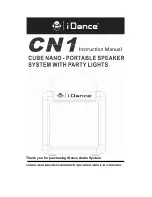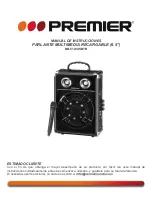
12
Turn all amplifier(s) OFF before connecting your speakers.
This will avoid damage which could result from accidental
shorting of speaker cables.
SPEAKER CONNECTION
Paradigm
®
Reference speakers have separate terminals for the high-frequency
input and low/mid-frequency input. These terminals are connected together
externally with jumper bars; the speaker cable (+) and (-) can then be connected
to either input terminal pair for standard connection. Removing the jumper
bars gives separate access to each frequency section of the speaker, which
then allows for two optional connection configurations, as outlined on the next
page—bi-wiring and bi-amplifying.
For optimum sound reproduction the use of high-quality speaker cable is
essential
(see Dealer for more information). The chart at right identifies the
minimum gauge requirements for various lengths.
Correct polarity (or phase), is critical for proper soundstage imaging and bass
performance. If you hear a distinct lack of bass and a dislocated stereo image
(from the front speakers), then one or more of your speakers may have been
connected out of phase (their polarity is reversed).
Connect one speaker at a time to ensure proper connection of every channel.
The red (+) amplifier terminal must be connected to the red (+) speaker terminal.
The same applies to the black (-) terminals. Make sure all wires are firmly
fastened. Repeat this connection procedure for each speaker in your system.
Standard Connection for Speakers with Two Input Teminals
(Fig. 7a)
Leave the jumper bars attached and connect using either set of input terminals.
Your speakers’ binding posts can be used with spade, banana or pin connectors,
as well as with bare wire. Tighten the posts firmly by hand—do not over tighten!
LENGTH
DIAMETER
GAUGE
Under 4.5 m (15 ft)
1.3 mm (0.05 in)
16 awg
Under 9 m (30 ft)
1.6 mm (0.06 in)
14 awg
Over 9 m (30 ft)
2.0 mm (0.08 in)
12 awg
MINIMUM GAUGE REQUIREMENTS
Paradigm DOES NOT supply hardware for mounting
brackets to the wall. If you are not comfortable performing
the on-wall mounting procedure, contact a professional
installer
(see Dealer).
A minimum amount of clearance is required to install
your speakers or remove them from the wall at a later date
(see Fig. 8g).
USING ADJUSTABLE ON-WALL BRACKETS
(included)
Brackets
(included) must be used when mounting On-Wall Left and Right
speakers and On-Wall Center Channel.
If desired, for better imaging or to optimize clarity you can adjust the angle
at which your speakers sit on the wall. You can:
•
Tilt front Left and Right speakers slightly inward for better imaging
(Fig. 8e, inset)
•
Tilt the center speaker up or down to further optimize clarity and
intelligibility (Fig. 8e, inset)
For complete details on wall-mounting your speakers see Pictorial Illustrations.
ATTACHING THE TV-TOP/SHELF SUPPORT
(Fig. 6)
WALL MOUNTING
(Figs. 8a-8g)
Your On-Wall Center-Channel speaker can also be placed on top of a TV, or on
a shelf using the TV-Top/Shelf Support included.
IMPORTANT!
If you are placing your speaker on top of a TV or
shelf, for stability you must use the TV-Top/Shelf Support included.
Installation is as follows:
1.
Connect speaker as outlined in “Speaker Connection” later in this manual;
run cable along channel visible on inside edge of the pre-assembled Support.
2.
Using the two screws
(included) attach Support to the back of the speaker.
3.
Apply self-adhesive rubber pads
(included) to bottom of speaker, as shown,
so that speaker sits securely and cannot slip.
4.
To adjust the speaker’s angle of tilt
(if desired), loosen screws and rotate
bracket up or down to achieve desired angle
(not shown). Retighten screws.
Summary of Contents for OM-1000
Page 3: ...UNPACKING INSTRUCTIONS pictorial 3 if included with your model ...
Page 4: ...4 Fig 1 Fig 1a Fig 1b Fig 2 SPEAKER PLACEMENT AND CONNECTION pictorial Fig 3 Fig 4 ...
Page 7: ...7 Fig 7a Fig 7b Fig 7c ...
Page 15: ...15 NOTES ...
Page 16: ...16 NOTES ...
Page 19: ...3 INSTRUCTIONS DE DÉBALLAGE figures si compris avec votre modèle ...
Page 20: ...4 Fig 1 Fig 1a Fig 1b Fig 2 POSITIONNEMENT ET RACCORDEMENT DES ENCEINTES figures Fig 3 Fig 4 ...
Page 23: ...7 Fig 7a Fig 7b Fig 7c ...
Page 31: ...15 NOTES ...
Page 32: ...16 NOTES ...













































